
A | B | C | D | E | F | G | H | CH | I | J | K | L | M | N | O | P | Q | R | S | T | U | V | W | X | Y | Z | 0 | 1 | 2 | 3 | 4 | 5 | 6 | 7 | 8 | 9
Mumbai
Muṁbaī Bombay | |
|---|---|
| Nickname(s): | |
| Coordinates: 19°04′34″N 72°52′39″E / 19.07611°N 72.87750°E | |
| Country | |
| State | |
| Division | Konkan |
| District | Mumbai City Mumbai Suburban |
| First settled | 1507[5] |
| Named for | Mumbadevi |
| Government | |
| • Type | Municipal Corporation |
| • Body | Brihanmumbai Municipal Corporation |
| • Mayor | Vacant[6][7] |
| • Administrator | I. S. Chahal, IAS[8] |
| Area | |
| • Megacity | 603.4 km2 (233.0 sq mi) |
| • Metro | 6,328 km2 (1,681.5 sq mi) |
| Elevation | 14 m (46 ft) |
| Population (2011)[10] | |
| • Megacity | 12,442,373 |
| • Rank | 1st |
| • Density | 21,000/km2 (53,000/sq mi) |
| • Metro | 18,414,288 20,748,395 (Extended UA) |
| Demonym(s) | Mumbaikar, Bombayite, Mumbaiite[12] |
| Time zone | UTC+5:30 (IST) |
| PINs | 400 001 to 400 107 |
| Area code | +91-22 |
| Vehicle registration |
|
| HDI | |
| International airport | Chhatrapati Shivaji Maharaj International Airport |
| Rapid Transit | Mumbai Metro and Mumbai Monorail |
| Official language | Marathi[15][16] |
| GDP Nominal | ₹5,96,783 crore (US$80.72 billion)[17] |
| Percapita | ₹3,44,394 (US$4,658)[17] |
| Website | mumbaicity |
| Official name | Elephanta Caves, Chhatrapati Shivaji Terminus, and The Victorian and Art Deco Ensemble of Mumbai |
| Type | Cultural |
| Criteria | i, ii, iii, iv |
| Designated | 1987, 2004, 2018 (11th, 28th 42nd sessions) |
| Reference no. | ; |
| Region | Southern Asia |
Mumbai (Marathi: [ˈmumbəi] , ISO: Muṁbaī; formerly known as Bombay[a]) is the capital city of the Indian state of Maharashtra. Mumbai is the financial capital and the most populous city of India with an estimated population of 12.5 million (1.25 crore).[18] Mumbai is the centre of the Mumbai Metropolitan Region, the sixth-most populous metropolitan area in the world with a population of over 23 million (2.3 crore).[19] Mumbai lies on the Konkan coast on the west coast of India and has a deep natural harbour. In 2008, Mumbai was named an alpha world city.[20][21] Mumbai has the highest number of billionaires out of any city in Asia.[22]
The seven islands that constitute Mumbai were earlier home to communities of Marathi language-speaking Koli people.[23][24][25] For centuries, the seven islands of Bombay were under the control of successive indigenous rulers before being ceded to the Portuguese Empire, and subsequently to the East India Company in 1661, through the dowry of Catherine Braganza when she was married off to Charles II of England.[26] Beginning in 1782, Mumbai was reshaped by the Hornby Vellard project,[27] which undertook reclamation of the area between the seven islands from the Arabian Sea.[28] Along with the construction of major roads and railways, the reclamation project, completed in 1845, transformed Mumbai into a major seaport on the Arabian Sea. Mumbai in the 19th century was characterised by economic and educational development. During the early 20th century it became a strong base for the Indian independence movement. Upon India's independence in 1947 the city was incorporated into Bombay State. In 1960, following the Samyukta Maharashtra Movement, a new state of Maharashtra was created with Mumbai as the capital.[29]
Mumbai is the financial, commercial,[30] and entertainment capital of South Asia. Mumbai is often compared to New York,[31][32] and the city is home to the Bombay Stock Exchange, situated on Dalal Street. It is also one of the world's top ten centres of commerce in terms of global financial flow,[33] generating 6.16% of India's GDP,[34] and accounting for 25% of the nation's industrial output, 70% of maritime trade in India (Mumbai Port Trust, Dharamtar Port and JNPT),[35] and 70% of capital transactions to India's economy.[36][37] The city houses important financial institutions and the corporate headquarters of numerous Indian companies and multinational corporations. The city is also home to some of India's premier scientific and nuclear institutes and the Hindi and Marathi film industries. Mumbai's business opportunities attract migrants from all over India.
Etymology
The name Mumbai (Marathi: मुंबई) originated from Mumbā or Mahā-Ambā—the name of the patron Hindu goddess (kuladevata) Mumbadevi of the native Koli community[38]—and from ā'ī, meaning "mother" in the Marathi language, which is the mother tongue of the Koli people and the official language of Maharashtra.[23][39] According to certain accounts, the Koli community, which hails from Kathiawar and Central Gujarat, is believed to have introduced their deity Mumba from Kathiawar (Gujarat), where her worship continues to this day.[24][25] However, other sources disagree that Mumbai's name was derived from the goddess Mumba.[25]
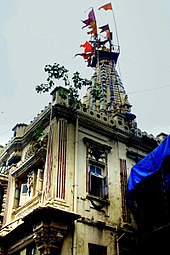
The oldest known names for the city are Kakamuchee and Galajunkja; these are sometimes still used.[40][41] Portuguese writer Gaspar Correia recorded the name "Bombaim" after 1512 in his Lendas da Índia (Legends of India).[42][43] While some Anglophone authors have suggested this name possibly originated as an alleged Galician-Portuguese phrase bom baim, meaning "good little bay",[44] such suggestions lack any scientific basis.[45] Portuguese linguist José Pedro Machado attributes that interpretation to a deficient knowledge of the Portuguese language of these authors, mixing up the Portuguese word "bom" with the English "bay", from the English version of the name.[45] In 1516, Portuguese explorer Duarte Barbosa used the name Tana-Maiambu: Tana appears to refer to the adjoining town of Thane and Maiambu to Mumbadevi.[46] The form Bombaim is still commonly used in Portuguese.[47]
Other variations recorded in the 16th and the 17th centuries include: Mombayn (1525), Bombay (1538), Bombain (1552), Bombaym (1552), Monbaym (1554), Mombaim (1563), Mombaym (1644), Bambaye (1666), Bombaiim (1666), Bombeye (1676), Boon Bay (1690)[47][48] and Bon Bahia.[49] After the English gained possession of the city in the 17th century, the Portuguese name was anglicised as Bombay.[50] Ali Muhammad Khan, imperial dewan or revenue minister of the Gujarat province, in the Mirat-i Ahmedi (1762) referred to the city as Manbai.[51]
The French traveller Louis Rousselet, who visited in 1863 and 1868, states in his book L'Inde des Rajahs, which was first published in 1877: "Etymologists have wrongly derived this name from the Portuguese Bôa Bahia, or (French: "bonne bai", English: "good bay"), not knowing that the tutelar goddess of this island has been, from remote antiquity, Bomba, or Mumba Devi, and that she still ... possesses a temple".[52]
By the late 20th century, the city was referred to as Mumbai or Mambai in Marathi, Konkani, Gujarati, Kannada and Sindhi, and as Bambai in Hindi.[53] The Government of India officially changed the English name to Mumbai in November 1995.[54] This came at the insistence of the Marathi nationalist Shiv Sena party, which had just won the Maharashtra state elections, and mirrored similar name changes across the country and particularly in Maharashtra.[55] According to Slate magazine, "they argued that 'Bombay' was a corrupted English version of 'Mumbai' and an unwanted legacy of British colonial rule."[56] Slate also said "The push to rename Bombay was part of a larger movement to strengthen Marathi identity in the Maharashtra region."[57] While Mumbai is still referred to as Bombay by some of its residents and by some Indians from other regions,[58][59] mention of the city by a name other than Mumbai has been controversial.[60][61]
People from Mumbai
A resident of Mumbai is called Mumbaikar (pronounced ) in Marathi, in which the suffix -kar means a resident of. The term had been in use for quite some time but it gained popularity after the official name change to Mumbai.[62] Older terms such as Bombayite are also used.[63][64]
History
 Bombay Presidency (1843–1947)
Bombay Presidency (1843–1947) Bombay State (1947–1960)
Bombay State (1947–1960) Maharashtra (1960–present)
Maharashtra (1960–present)
Early history
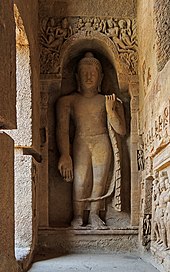
Mumbai is built on what was once an archipelago of seven islands: Isle of Bombay, Parel, Mazagaon, Mahim, Colaba, Worli, and Old Woman's Island (also known as Little Colaba).[65] It is not exactly known when these islands were first inhabited. Pleistocene sediments found along the coastal areas around Kandivali in northern Mumbai suggest that the islands were inhabited since the South Asian Stone Age.[66] Perhaps at the beginning of the Common Era, or possibly earlier, they came to be occupied by the Koli fishing community.[67][68]
In the 3rd century BCE, the islands formed part of the Maurya Empire, during its expansion in the south, ruled by the Buddhist emperor Ashoka of Magadha.[69] The Kanheri Caves in Borivali were excavated from basalt rock in the first century CE,[70] and served as an important centre of Buddhism in Western India during ancient Times.[71] The city then was known as Heptanesia (Ancient Greek: A Cluster of Seven Islands) to the Greek geographer Ptolemy in 150 CE.[72] The Mahakali Caves in Andheri were cut out between the 1st century BCE and the 6th century CE.[73][74]
Between the 2nd century BCE and 9th century CE, the islands came under the control of successive indigenous dynasties: Satavahanas, Western Satraps, Abhira, Vakataka, Kalachuris, Konkan Mauryas, Chalukyas and Rashtrakutas,[75] before being ruled by the Shilaharas from 810 to 1260.[76] Some of the oldest edifices in the city built during this period are the Jogeshwari Caves (between 520 and 525),[77] Elephanta Caves (between the sixth to seventh century),[78] Walkeshwar Temple (10th century),[79][80] and Banganga Tank (12th century).[81][82]

King Bhimdev founded his kingdom in the region in the late 13th century and established his capital in Mahikawati (present day Mahim).[83] The Pathare Prabhus, among the earliest known settlers of the city, were brought to Mahikawati from Saurashtra in Gujarat around 1298 by Bhimdev.[84] The Delhi Sultanate annexed the islands in 1347–48 and controlled it until 1407. During this time, the islands were administered by the Muslim Governors of Gujarat, who were appointed by the Delhi Sultanate.[85][86]
The islands were later governed by the independent Gujarat Sultanate, which was established in 1407. As a result of the Sultanate's support, numerous mosques were built, with one notable example being the Haji Ali Dargah in Worli. Erected in 1431, this magnificent structure pays homage to the revered Muslim saint, Haji Ali.[87] From 1429 to 1431, the islands were a source of contention between the Gujarat Sultanate and the Bahmani Sultanate of Deccan.[88][89] In 1493, Bahadur Khan Gilani of the Bahmani Sultanate attempted to conquer the islands but was defeated.[90]
Portuguese and British rule

The Mughal Empire, founded in 1526, was the dominant power in the Indian subcontinent during the mid-16th century.[91] Growing apprehensive of the power of the Mughal emperor Humayun, Sultan Bahadur Shah of Gujarat was obliged to sign the Treaty of Bassein with the Portuguese Empire on 23 December 1534. According to the treaty, the Seven Islands of Bombay, the nearby strategic town of Bassein and its dependencies were offered to the Portuguese. The territories were later surrendered on 25 October 1535.[92]

The Portuguese were actively involved in the foundation and growth of their Roman Catholic religious orders in Bombay.[93] They called the islands by various names, which finally took the written form Bombaim. The islands were leased to several Portuguese officers during their regime. The Portuguese Franciscans and Jesuits built several churches in the city, prominent being the St. Michael's Church at Mahim (1534),[94] St. John the Baptist Church at Andheri (1579),[95] St. Andrew's Church at Bandra (1580),[96] and Gloria Church at Byculla (1632).[97] The Portuguese also built several fortifications around the city like the Bombay Castle, Castella de Aguada (Castelo da Aguada or Bandra Fort), and Madh Fort. The English were in constant struggle with the Portuguese vying for hegemony over Mumbai, as they recognised its strategic natural harbour and its natural isolation from land attacks. By the middle of the 17th century the growing power of the Dutch Empire forced the English to acquire a station in western India. On 11 May 1661, the marriage treaty of Charles II of England and Catherine of Braganza, daughter of King John IV of Portugal, placed the islands in possession of the English Empire, as part of Catherine's dowry to Charles.[98] However, Salsette, Bassein, Mazagaon, Parel, Worli, Sion, Dharavi, and Wadala still remained under Portuguese possession. From 1665 to 1666, the English managed to acquire Mahim, Sion, Dharavi, and Wadala.[99]

In accordance with the Royal Charter of 27 March 1668, England leased these islands to the English East India Company in 1668 for a sum of £10 per annum.[100] The population quickly rose from 10,000 in 1661, to 60,000 in 1675.[101] The islands were subsequently attacked by Yakut Khan, the Muslim Koli[102][103][104][105] admiral of the Mughal Empire, in October 1672,[106] Rickloffe van Goen, the Governor-General of Dutch India on 20 February 1673,[107] and Siddi admiral Sambal on 10 October 1673.[106]
In 1687, the English East India Company transferred its headquarters from Surat to Mumbai. The city eventually became the headquarters of the Bombay Presidency.[108] Following the transfer, Mumbai was placed at the head of all the company's establishments in India.[109] Towards the end of the 17th century, the islands again suffered incursions from Yakut Khan in 1689–90.[110] The Portuguese presence ended in Mumbai when the Marathas under Peshwa Baji Rao I captured Salsette in 1737, and Bassein in 1739.[111] By the middle of the 18th century, Mumbai began to grow into a major trading town, and received a huge influx of migrants from across India.[112] Later, the British occupied Salsette on 28 December 1774. With the Treaty of Surat (1775), the British formally gained control of Salsette and Bassein, resulting in the First Anglo-Maratha War.[113] The British were able to secure Salsette from the Marathas without violence through the Treaty of Purandar (1776),[114] and later through the Treaty of Salbai (1782), signed to settle the outcome of the First Anglo-Maratha War.[115]
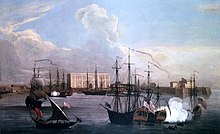
From 1782 onwards, the city was reshaped with large-scale civil engineering projects aimed at merging all the seven islands of Bombay into a single amalgamated mass by way of a causeway called the Hornby Vellard, which was completed by 1784.[27][116] In 1817, the British East India Company under Mountstuart Elphinstone defeated Baji Rao II, the last of the Maratha Peshwa in the Battle of Khadki.[117] Following his defeat, almost the whole of the Deccan Plateau came under British suzerainty, and was incorporated into the Bombay Presidency. The success of the British campaign in the Deccan marked the end of all attacks by native powers.[118]
By 1845, the seven islands coalesced into a single landmass by the Hornby Vellard project via large scale land reclamation.[28][119] On 16 April 1853, India's first passenger railway line was established, connecting Mumbai to the neighbouring town of Thana (now Thane).[120] During the American Civil War (1861–1865), the city became the world's chief cotton-trading market, resulting in a boom in the economy that subsequently enhanced the city's stature.[121]
The opening of the Suez Canal in 1869 transformed Mumbai into one of the largest seaports on the Arabian Sea.[122] In September 1896, Mumbai was hit by a bubonic plague epidemic where the death toll was estimated at 1,900 people per week.[123] About 850,000 people fled Mumbai and the textile industry was adversely affected.[124] While the city was the capital of the Bombay Presidency, the Indian independence movement fostered the Quit India Movement in 1942 and the Royal Indian Navy mutiny in 1946.[125][126]
Independent India
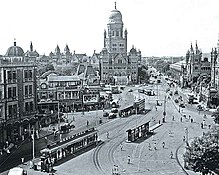
After India's independence in 1947, the territory of the Bombay Presidency retained by India was restructured into Bombay State. The area of Bombay State increased, after several erstwhile princely states that joined the Indian union were integrated into the state. Subsequently, the city became the capital of Bombay State.[127] In April 1950, Municipal limits of Mumbai were expanded by merging the Mumbai Suburban District and Mumbai City to form the Greater Mumbai Municipal Corporation.[128]
The Samyukta Maharashtra movement to create a separate Maharashtra state including Mumbai was at its height in the 1950s. In the Lok Sabha discussions in 1955, the Congress party demanded that the city be constituted as an autonomous city-state.[129] The States Reorganisation Committee recommended a bilingual state for Maharashtra–Gujarat with Mumbai as its capital in its 1955 report. Bombay Citizens' Committee, an advocacy group of leading Gujarati industrialists lobbied for Mumbai's independent status.[130]
Following protests during the movement in which 105 people died in clashes with the police, Bombay State was reorganised on linguistic lines on 1 May 1960.[131] Gujarati-speaking areas of Bombay State were partitioned into the state of Gujarat.[132] Maharashtra State with Mumbai as its capital was formed with the merger of Marathi-speaking areas of Bombay State, eight districts from Central Provinces and Berar, five districts from Hyderabad State, and numerous princely states enclosed between them.[133] As a memorial to the martyrs of the Samyukta Maharashtra movement, Flora Fountain was renamed as Hutatma Chowk (Martyr's Square) and a memorial was erected.[134]
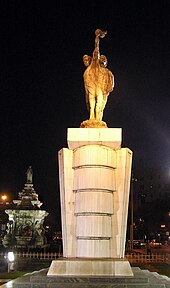
The following decades saw massive expansion of the city and its suburbs. In the late 1960s, Nariman Point and Cuffe Parade were reclaimed and developed.[135] The Mumbai Metropolitan Region Development Authority (BMRDA) was established on 26 January 1975 by the Government of Maharashtra as an apex body for planning and co-ordination of development activities in the Mumbai metropolitan region.[136] In August 1979, a sister township of New Mumbai was founded by the City and Industrial Development Corporation (CIDCO) across the Thane and Raigad districts to help the dispersal and control of Mumbai's population. The textile industry in Mumbai largely disappeared after the widespread 1982 Great Bombay Textile Strike, in which nearly 250,000 workers in more than 50 textile mills went on strike.[137] Mumbai's defunct cotton mills have since become the focus of intense redevelopment.[138][139] Industrial development began in Mumbai when its economy started focusing on the petrochemical, electronic, and automotive sectors. In 1954 Hindustan Petroleum comissoned Mumbai Refinery at Trombay and BPCL Refinery.[140]
The Jawaharlal Nehru Port, which handles 55–60% of India's containerised cargo, was commissioned on 26 May 1989 across the creek at Nhava Sheva with a view to de-congest Mumbai Harbour and to serve as a hub port for the city.[141] The geographical limits of Greater Mumbai were coextensive with municipal limits of Greater Mumbai. On 1 October 1990, the Greater Mumbai district was bifurcated to form two revenue districts namely, Mumbai City and Mumbai Suburban, though they continued to be administered by same Municipal Administration.[142]
The years from 1990 to 2010 saw an increase in violence and terrorism activities. Following the demolition of the Babri Masjid in Ayodhya, the city was rocked by the Hindu-Muslim riots of 1992–93 in which more than 1,000 people were killed. In March 1993, a series of 13 coordinated bombings at several city landmarks by Islamic extremists and the Mumbai underworld resulted in 257 deaths and over 700 injuries.[143] In 2006, 209 people were killed and over 700 injured when seven bombs exploded on the city's commuter trains.[144] In 2008, a series of ten coordinated attacks by armed terrorists for three days resulted in 173 deaths, 308 injuries, and severe damage to several heritage landmarks and prestigious hotels.[145] The three coordinated bomb explosions in July 2011 that occurred at the Opera house, Zaveri Bazaar and Dadar were the latest in the series of terrorist attacks in Mumbai which resulted in 26 deaths and 130 injuries.[146][147]
Mumbai is the commercial capital of India and has evolved into a global financial hub.[148] For several decades it has been the home of India's main financial services companies, and a focus for both infrastructure development and private investment.[149] From being an ancient fishing community and a colonial centre of trade, Mumbai has become South Asia's largest city and home of the world's most prolific film industry.[150]
Geography
Mumbai is on a narrow peninsula on the southwest of Salsette Island, which lies between the Arabian Sea to the west, Thane Creek to the east and Vasai Creek to the north. Mumbai's suburban district occupies most of the island. Navi Mumbai is east of Thane Creek and Thane is north of Vasai Creek. Mumbai consists of two distinct regions: Mumbai City district and Mumbai Suburban district, which form two separate revenue districts of Maharashtra.[151] The city district region is also commonly referred to as the Island City or South Mumbai.[34] The total area of Mumbai is 603.4 square kilometres (233.0 sq mi).[152] Of this, the island city spans 67.79 square kilometres (26.17 sq mi), while the suburban district spans 370 square kilometres (140 sq mi), together accounting for 437.71 square kilometres (169.00 sq mi) under the administration of Municipal Corporation of Greater Mumbai (MCGM). The remaining areas belong to various Defence establishments, the Mumbai Port Trust, the Atomic Energy Commission and the Borivali National Park, which are out of the jurisdiction of the MCGM.[153] The Mumbai Metropolitan Region which includes portions of Thane, Palghar and Raigad districts in addition to Greater Mumbai, covers an area of 4,355 square kilometres (1,681 sq mi).[9] Mumbai lies at the mouth of the Ulhas River on the western coast of India, in the coastal region known as the Konkan. It sits on Salsette Island (Sashti Island), which it partially shares with the Thane district.[154] Mumbai is bounded by the Arabian Sea to the west.[155] Many parts of the city lie just above sea level, with elevations ranging from 10 to 15 metres (33 to 49 ft);[156] the city has an average elevation of 14 metres (46 ft).[157] Northern Mumbai (Salsette) is hilly,[158] and the highest point in the city is 450 metres (1,480 ft) at Salsette in the Powai–Kanheri ranges.[159] The Sanjay Gandhi National Park (Borivali National Park) is located partly in the Mumbai suburban district, and partly in the Thane district, and it extends over an area of 103.09 square kilometres (39.80 sq mi).[160]
Apart from the Bhatsa Dam, there are six major lakes that supply water to the city: Vihar, Lower Vaitarna, Upper Vaitarna, Tulsi, Tansa and Powai. Tulsi Lake and Vihar Lake are located in Borivili National Park, within the city's limits. The supply from Powai lake, also within the city limits, is used only for agricultural and industrial purposes.[161] Three small rivers, the Dahisar River, Poinsar (or Poisar) and Ohiwara (or Oshiwara) originate within the park, while the Mithi River originates from Tulsi Lake and gathers water overflowing from Vihar and Powai Lakes.[162] The coastline of the city is indented with numerous creeks and bays, stretching from the Thane creek on the eastern to Madh Marve on the western front.[163] The eastern coast of Salsette Island is covered with large mangrove swamps, rich in biodiversity, while the western coast is mostly sandy and rocky.[164]
Soil cover in the city region is predominantly sandy due to its proximity to the sea. In the suburbs, the soil cover is largely alluvial and loamy.[165] The underlying rock of the region is composed of black Deccan basalt flows, and their acidic and basic variants dating back to the late Cretaceous and early Eocene eras.[166] Mumbai sits on a seismically active zone owing to the presence of 23 fault lines in the vicinity.[167] The area is classified as a Seismic Zone III region,[168] which means an earthquake of up to magnitude 6.5 on the Richter magnitude scale may be expected.[169]
-
Satellite image of Mumbai
-
Mumbai consists of two revenue districts.
Climate
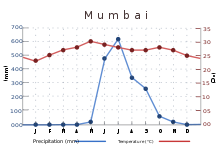

Mumbai has an extreme tropical wet and dry climate (Aw) under the Köppen climate classification, although the central and northern suburbs have a tropical monsoon climate (Am) with even heavier wet season rainfall. Mumbai has a virtually rainless period extending from October to May and an extremely wet period peaking in July.[170] A cooler season from December to February is followed by a hotter season from March to May. The period from June to about the end of September constitutes the south west monsoon season, and October and November form the post-monsoon season.[171]
Between June and September, the South-west monsoon rains occur in Mumbai. Pre-monsoon showers are received in May. Occasionally, north-east monsoon showers occur in October and November. The maximum annual rainfall ever recorded was 3,452 mm (136 in) for 1954.[172] The highest rainfall recorded in a single day was 944 mm (37 in) on 26 July 2005.[173] The average total annual rainfall is 2,213.4 mm (87 in) for the Island City, and 2,502.3 mm (99 in) for the suburbs.[172]
The average annual temperature is 27 °C (81 °F), and the average annual precipitation is 2,213 mm (87 in).[174] In the Island City, the average maximum temperature is 31 °C (88 °F), while the average minimum temperature is 24 °C (75 °F). In the suburbs, the daily mean maximum temperature range from 29 °C (84 °F) to 33 °C (91 °F), while the daily mean minimum temperature ranges from 16 °C (61 °F) to 26 °C (79 °F).[172] The record high is 42.2 °C (108 °F) set on 14 April 1952,[175] and the record low is 7.4 °C (45 °F) set on 27 January 1962.[175][176]
Tropical cyclones are rare in the city. The worst cyclone to ever impact Mumbai was the one in 1948 where gusts reached 151 km/h (94 mph) in Juhu. The storm left 38 people dead and 47 missing. The storm reportedly impacted Mumbai for 20 hours and left the city devastated.[177][178][179]
Mumbai is prone to monsoon floods,[180][181] exacerbated by climate change which affects heavy rains and high tide in the sea. According to the World Bank, unplanned drainage system and informal settlement is a key factor of frequent floods in Mumbai.[182] Among other causes of flooding in Mumbai is its geographic location, Mumbai urban is peninsular in form, (a land-filled area that connects seven islands) a low laying area, compared to its suburbs that sit on an elevated location. Over the past few decades, new informal settlements were formed in the suburbs, causing a rapid increase in population, improper waste management, and drainage congestion. The rainwater from these areas heavily flows towards low-lying urban areas consisting of some slums and high-rise buildings. As a result, slums are either swamped, washed away, or collapse causing heavy casualties, and post-flood water logging lasts for a long time that causing blockage of railway lines-(most frequently used public transport in Mumbai), traffic snarl, inundated roads, and sub-merged bylanes. Over the past few decades, the frequency of floods in Mumbai is enormous, the 2005 Mumbai floods are characterised by 500-1000 deaths, household displacements, damaged infrastructure-(including heritage sites), and a financial loss of US$ 1.2 billion.[182][183] In the process of reducing floods in Mumbai, the Maharashtra government adopted a flood mitigation plan; according to which the drainage system will be restructured, restoration of Mithi River, and re-establishment of informal settlements. Local civic body Brihanmumbai Municipal Corporation (BMC) authorities are assigned to forecast and issue eviction notices while BMC along with NGO's prepare for the evacuation of the residents of those areas to temporary safe camps.[182][183][184]
| Month | Jan | Feb | Mar | Apr | May | Jun | Jul | Aug | Sep | Oct | Nov | Dec | Year |
|---|---|---|---|---|---|---|---|---|---|---|---|---|---|
| Record high °C (°F) | 37.0 (98.6) |
38.3 (100.9) |
41.6 (106.9) |
40.6 (105.1) |
39.7 (103.5) |
37.2 (99.0) |
35.6 (96.1) |
33.8 (92.8) |
35.6 (96.1) |
39.5 (103.1) |
38.4 (101.1) |
36.7 (98.1) |
41.6 (106.9) |
| Mean maximum °C (°F) | 34.4 (93.9) |
34.9 (94.8) |
35.8 (96.4) |
35.1 (95.2) |
35.4 (95.7) |
35.0 (95.0) |
32.1 (89.8) |
31.7 (89.1) |
32.7 (90.9) |
36.4 (97.5) |
36.3 (97.3) |
35.3 (95.5) |
37.6 (99.7) |
| Mean daily maximum °C (°F) | 30.2 (86.4) |
30.3 (86.5) |
31.7 (89.1) |
32.9 (91.2) |
34.0 (93.2) |
32.2 (90.0) |
29.9 (85.8) |
29.9 (85.8) |
30.6 (87.1) |
33.1 (91.6) |
33.8 (92.8) |
32.2 (90.0) |
31.7 (89.1) |
| Daily mean °C (°F) | 24.9 (76.8) |
25.5 (77.9) |
27.3 (81.1) |
29.2 (84.6) |
30.7 (87.3) |
29.3 (84.7) |
27.7 (81.9) |
27.5 (81.5) |
27.9 (82.2) |
29.1 (84.4) |
28.7 (83.7) |
26.7 (80.1) |
27.9 (82.2) |
| Mean daily minimum °C (°F) | 19.4 (66.9) |
20.4 (68.7) |
23.0 (73.4) |
25.3 (77.5) |
27.3 (81.1) |
26.6 (79.9) |
25.5 (77.9) |
25.2 (77.4) |
25.1 (77.2) |
25.1 (77.2) |
23.6 (74.5) |
21.2 (70.2) |
24 (75) |
| Mean minimum °C (°F) | 16.0 (60.8) |
17.1 (62.8) |
20.0 (68.0) |
22.9 (73.2) |
25.0 (77.0) |
23.3 (73.9) |
23.3 (73.9) Zdroj:https://en.wikipedia.org?pojem=Bombay,_India Text je dostupný za podmienok Creative Commons Attribution/Share-Alike License 3.0 Unported; prípadne za ďalších podmienok. Podrobnejšie informácie nájdete na stránke Podmienky použitia.
Analytika
Antropológia Aplikované vedy Bibliometria Dejiny vedy Encyklopédie Filozofia vedy Forenzné vedy Humanitné vedy Knižničná veda Kryogenika Kryptológia Kulturológia Literárna veda Medzidisciplinárne oblasti Metódy kvantitatívnej analýzy Metavedy Metodika Text je dostupný za podmienok Creative
Commons Attribution/Share-Alike License 3.0 Unported; prípadne za ďalších
podmienok. www.astronomia.sk | www.biologia.sk | www.botanika.sk | www.dejiny.sk | www.economy.sk | www.elektrotechnika.sk | www.estetika.sk | www.farmakologia.sk | www.filozofia.sk | Fyzika | www.futurologia.sk | www.genetika.sk | www.chemia.sk | www.lingvistika.sk | www.politologia.sk | www.psychologia.sk | www.sexuologia.sk | www.sociologia.sk | www.veda.sk I www.zoologia.sk | ||||||














